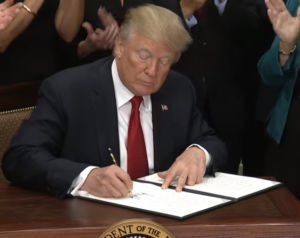Trump signs executive order to begin replacing Obamacare with better health care choices
After repeated efforts to repeal and replace Obamacare in Congress, President Trump signed an executive order today directing federal agencies to take specific steps to give Americans more and better health care choices.
In just three short years, Obamacare has severely damaged health insurance markets across the country, leaving some markets on the brink of total collapse. Going into 2018, consumers will have access to just one health carrier in nearly half of the counties across America. In many cases, this sole health carrier does not include local doctors in its network, forcing people to switch doctors and drive long distances for care. Average premiums on the individual health insurance market have doubled since 2013, escalating premiums beyond what most people can afford.
 To address these severe problems, Trump’s executive order directs executive agencies to take three major steps. First, the order directs the Secretary of Labor to consider expanding access to association health plans. This move has the potential to allow Americans to more easily form groups through existing organizations—such as a trade organization—to gain access to more insurance options at lower rates in the large group market or on a self-funded basis.
To address these severe problems, Trump’s executive order directs executive agencies to take three major steps. First, the order directs the Secretary of Labor to consider expanding access to association health plans. This move has the potential to allow Americans to more easily form groups through existing organizations—such as a trade organization—to gain access to more insurance options at lower rates in the large group market or on a self-funded basis.
Second, the order directs agencies to consider expanding access to lower cost health coverage options by easing restrictions on short-term limited duration insurance. This type of insurance generally exists to provide health coverage to people between jobs. After Obamacare became law, the Obama administration shortened the allowable duration of these plans from 364 to 90 days, a move opposed by the National Association of Insurance Commissioners. Because these plans are not subject to costly Obamacare regulations, they cost remarkably less than standard coverage. Moreover, as normally structured, they provide access to any doctor, a very important benefit for people living in those counties with very narrow networks.
Third, the order directs agencies to consider giving employers more flexibility in designing and offering health reimbursement arrangements (HRAs) to their employees. Prior to Obamacare, HRAs were health care accounts employers could create for employees to fund a broad array of health care expenses on a pre-tax basis, including individual health insurance premiums. The Obama administration, however, banned employers from using HRAs and other arrangements to fund individual market premiums pre-tax.
This final directive should reverse this ban and allow employers to establish defined contribution health plans that provide employees with cash to go into the individual market and choose their own health plan with pre-tax dollars. Importantly, this type of health plan would be portable from job to job.
I’ve taken a particular interest in this issue because a move toward individually-owned health plans would help remove one of the major distortions in the health care system. Because the federal tax code preferences employer-sponsored health coverage, no one really shops for health insurance. That means there’s very little competitive pressure for health insurers to meet the demands of individual consumers and, in particular, demands for lower cost care. Instead, insurers focus on satisfying employers.
The Trump administration is on sound legal footing to roll back this ban. As far as I’ve seen, I’m the only attorney to subject Obama’s ban to serious legal scrutiny before Trump took office. In a detailed white paper on the issue, I concluded the ban “contradicts prior federal court and agency holdings and, moreover, conflicts with provisions in the ACA that show Congress intended to continue allowing employers to fund individual premiums pre-tax.” Simply put, the ACA never empowered the Obama administration to bar employers from funding individual health insurance. Trump’s executive order will correct this.
Overall, in response to collapsing insurance markets, Trump’s executive order takes a first step to give better options for more affordable coverage to millions of Americans. But it is only a first step. America still needs a more complete solution to address Obamacare’s failures.